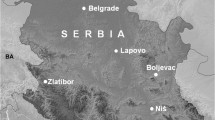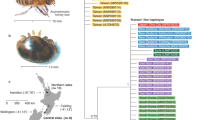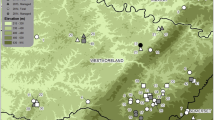Abstract
Mites in the genus Tropilaelaps are parasites of social honeybees. Two species, Tropilaelaps clareae and T. koenigerum, have been recorded and their primary hosts are presumed to be the giant honeybees of Asia, Apis dorsata and A. laboriosa. The most common species, T. clareae, is also an economically important pest of the introduced Western honeybee (A. mellifera) throughout Asia and is considered an emerging threat to world apiculture. In the studies reported here, genetic (mtDNA CO-I and nuclear ITS1-5.8S-ITS2 gene sequence) and morphological variation and host associations were examined among Tropilaelaps isolates collected from A. dorsata, A. laboriosa and A. mellifera throughout Asia and neighbouring regions. The results clearly indicate that the genus contains at least four species. Tropilaelaps clareae, previously assumed to be ubiquitous in Asia, was found to be two species, and it is here redefined as encompassing haplotypes (mites with distinct mtDNA gene sequences) that parasitise native A. dorsata breviligula and introduced A. mellifera in the Philippines and also native A. d. binghami on Sulawesi Island in Indonesia. Tropilaelaps mercedesae n. sp., which until now has been mistaken for T. clareae, encompasses haplotypes that, together with haplotypes of T. koenigerum, parasitise native A. d. dorsata in mainland Asia and Indonesia (except Sulawesi Island). It also parasitises introduced A. mellifera in these and surrounding regions and, with another new species, T. thaii n. sp., also parasitises A. laboriosa in mountainous Himalayan regions. Methods are described for identifying each species. These studies help to clarify the emerging threat of Tropilaelaps to world apiculture and will necessitate a revision of quarantine protocols for countries that import and export honeybees.









Similar content being viewed by others
References
Aggarwal K (1988) Incidence of Tropilaelaps clareae on three Apis species in Hisar (India). In: Needham GR, Page RE Jr, Delfinado-Baker M, Bowan CE (eds) Africanised honey bees and bee mites. Halsted Press, New York, pp 396–403
Anderson DL (1994) Non-reproduction of Varroa jacobsoni in Apis mellifera colonies in Papua New Guinea and Indonesia. Apidologie 25:412–421
Anderson DL, Fuchs S (1998) Two genetically distinct populations of Varroa jacobsoni with contrasting reproductive abilities on Apis mellifera. J Apic Res 37:69–78
Anderson DL, Trueman JWH (2000) Varroa jacobsoni is more than one species. Exp Appl Acarol 24:165–189
Anderson DL, Gibbs AJ, Gibson NL (1998) Identification and phylogeny of spore-cyst fungi (Ascosphaera spp.) using ribosomal DNA sequences. Mycol Res 102:541–547
Archie JW (1989) A randomization test for phylogenetic information in systematic data. Syst Zool 38:239
Arias MC, Sheppard WS (2005) Phylogenetic relationships of honey bees (Hymenoptera: Apinae:Apini) inferred from nuclear and mitochondrial DNA sequence data. Mol Phylogenet Evol 37:25–35
Burgett M, Akratanakul P, Morse RA (1983) Tropilaelaps clareae: a parasite of honeybees in south-east Asia. Bee World 64:25–28
Burgett DM, Rossignol PA, Kiprasert C (1990) A model of dispersion and regulation of brood mite (Tropilaelaps clareae) parasitism on the giant honeybee (Apis dorsata). Can J Zool 68:1423–1427
Delfinado-Baker M (1982) New records for Tropilaelaps clareae from colonies of Apis cerana indica. Am Bee J 122:382
Delfinado-Baker M, Aggarwal K (1987) Infestation of Tropilaelaps clareae and Varroa jacobsoni in Apis mellifera ligustica colonies in Papua New Guinea. Am Bee J 127:443
Delfinado MD, Baker EW (1961) Tropilaelaps, a new species of mite from the Philippines (Laelaptidae [s. lat]: Acarina). Fieldiana Zool 44:53–56
Delfinado-Baker M, Baker EW (1982) A new species of Tropilaelaps parasitic on honey bees. Am Bee J 122:416–417
Delfinado-Baker M, Underwood BA, Baker EW (1985) The occurrence of Tropilaelaps mites in brood nests of Apis dorsata and A. laboriosa in Nepal, with descriptions of the nymphal stages. Am Bee J 125:703–706
Delfinado-Baker M, Baker EW, Phoon ACG (1989) Mites (Acari) associated with bees (Apidae) in Asia, with description of a new species. Am Bee J 129:609–613
Efron B, Halloran E, Holmes S (1996) Bootstrap confidence levels for phylogenetic trees. Proc Natl Acad Sci USA 93:13429–13434
Felsenstein J (1978) Cases in which parsimony of compatibility methods will be positively misleading. Syst Zool 27:401–410
Hillis DM, Bull JJ (1993) An empirical-test of bootstrapping as a method for assessing confidence in phylogenetic analysis. Syst Biol 42:182–192
Kavinseksan B, Wongsiri S, De Guzman LI, Rinderer TE (2004) Absence of Tropilaelaps infestation from recent swarms of Apis dorsata in Thailand. J Apic Res 42:49–50
Koeniger N, Koeniger G, Delfinado-Baker M (1983) Observations on mites of the Asian honeybee species (Apis cerana, Apis dorsata, Apis florea). Apidologie 14:197–204
Koeniger G, Koeniger N, Anderson DL, Lekprayoon C, Tingek S (2002) Mites from debris and sealed brood cells of Apis dorsata colonies in Sabah (Borneo) Malaysia, including a new haplotype of Varroa jacobsoni. Apidologie 33:15–24
Krantz GW (1978) A manual of acarology. Oregon State University Bookstores, Corvallis
Kumar NR, Kumar R, Mbaya I, Mwangi RW (1993) Tropilaelaps clareae found on Apis mellifera in Africa. Bee World 74:101–102
Laigo FM, Morse RA (1968) The mite Tropilaelaps clareae in Apis dorsata colonies in the Philippines. Bee World 49:116–118
Lockhart PJ, Howe CJ, Bryant DA, Beanland TJ, Larkum AWD (1992) Substitutional bias confounds inference of cyanelle origins from sequence data. J Mol Evol 34:153–162
Lockhart PJ, Steel MA, Hendy MD, Penny D (1994) Recovering evolutionary trees under a more realistic model of sequence evolution. Mol Biol Evol 11: 605–612
Matheson A (1996) World bee health update 1996. Bee World 77:45–51
Navajas M, Fenton B (2000) The application of molecular markers in the study of diversity in acarology: a review. Exp Appl Acarol 24:751–774
Navajas M, Gutierrez J, Bonato O, Bolland HR, Mapangou-Divassa S (1994) Intraspecific diversity of the cassava green mite Mononychellus progresivus (Acari: Tetranychidae) using comparisons of mitochondrial and nuclear ribosomal DNA sequences and cross-breeding. Exp Appl Acarol 18:351–360
Navajas M, Lagnel J, Gutierrez J, Boursot P (1998) Species-wide homogeneity of nuclear ribosomal ITS2 sequences in the spider mite Tetranychus urticae contrasts with extensive mitochondrial CO1 polymorphism. Heredity 80:742–752
Navajas M, Le Conte Y, Solignac M, Cros-Arteil S, Cornuet JM (2002) The complete sequence of the mitochondrial genome of the honeybee ectoparasite mite Varroa destructor (Acari: Mesostigmata). Mol Biol Evol 19:2313–2317
OIE (2004) Tropilaelaps infestation of honey bees (Tropilaelaps clareae, T. koenigerum). In: Manual of diagnostic tests and vaccines for terrestrial animals (mammals, birds and bees), chap 2.9.6, 5th edn. Office International des Epizooties, Paris
Otis GW (1996) Distributions of recently recognized species of honey bee (Hymenoptera: Apidae; Apis) in Asia. J Kan Entomol Soc 69:311–333
Otis GW, Kralj J (2001) Parasitic brood mites not present in North America. In: Webster TC, Delaplane KS (eds) Mites of the honey bee. Dadant and Sons, Illinois, pp 251–272
Posada D, Crandall KA (1998) MODELTEST: testing the model of DNA substitution. Bioinformatics 14:817–818
Ruttner F (1988) Biogeography and taxonomy of honeybees. Springer, Berlin
Saiki RK (1990) Amplification of genomic DNA. In: Innis MA, Gelfand DH, Sninsky JJ, White TJ (eds) PCR protocols. Academic Press, San Diego, pp 13–20
Sakagami ShF, Matsumura T, Ito K (1980) Apis laboriosa in Himalaya. The little known worlds largest honeybee (Hymenoptera, Apidae). Insecta Matsumurana 19:47–77
Sammataro D, Gerson U, Needham G (2000) Parasitic mites of honey bees: life history, implications and impact. Annu Rev Entomol 45:519–548
Simmons MP, Ochoterena H (2000) Gaps as characters in sequence-based phylogenetic analyses. Syst Biol 49:369–381
Simmons MP, Carr TG, O’Neill K (2004) Relative character-state space, amount of potential phylogenetic information, and heterogeneity of nucleotide and amino acid characters. Mol Phylogenet Evol 32:913–926
Smith DR, Villafuerte L, Otis G, Palmer MR (2000) Biogeography of Apis cerana F. and A. nigrocincta Smith: insights from mtDNA studies. Apidologie 31:265–279
Steel M (1994) Recovering a tree from the Markov leaf colourations it generates under a Markov model. Appl Math Lett 7:19–23
Swofford DL (1998) PAUP*: phylogenetic analysis using parsimony (* and other methods). Version 4.0d64. Sinauer Associates, Sunderland
Tangjingjai W, Verakalasa P, Sittipraneed S, Klinbunga S, Lekprayoon C (2003) Genetic differences between Tropilaelaps clareae and Tropilaelaps koenigerum in Thailand based on ITS and RAPD analyses. Apidologie 34:514–524
Tangkanasing P, Wongsiri S, Vongsamanode (1988) Integrated control of Varroa jacobsoni and Tropilaelaps clareae in bee hives in Thailand. In: Needham GR, Page RE Jr, Delfinado-Baker M, Bowan CE (eds) Africanised honey bees and bee mites. Halsted Press, New York, pp 409–412
Toda S, Osakabe MH, Komazaki S (2000) Interspecific diversity of mitochondrial CO-I sequences in Japanese Panonychus species (Acari: Tetranychidae). Exp Appl Acarol 24:821–829
Walter DE, Campbell NJH (2003) Exotic vs endemic biocontrol agents: would the real Stratiolaelaps miles (Berlese) Acari: Mesostigmata: Laelapidae), please stand up? Biol Control 26:253–269
White TJ, Bruns T, Lee S, Tayler J (1990) Amplification and direct sequencing of fungal ribosomal RNA genes for phylogenetics. In: Innis MA, Gelfand DH, Sninsky JJ, White TJ (eds) PCR protocols. Academic Press, San Diego, pp 315–322
Woyke J (1984) Survival and prophylactic control of Tropilaelaps clareae infesting Apis mellifera colonies in Afghanistan. Apidologie 15:421–434
Woyke J (1987) Length of successive stages in the development of the mite Tropilaelaps clareae in relation to honeybee brood age. J Apic Res 26:110–114
Woyke J (1994) Mating behaviour of the parasitic honeybee mite Tropilaelaps clareae. Exp Appl Acarol 18:723–733
Acknowledgments
We thank the numerous friends, colleagues and traditional ‘honey-hunters’ that assisted with the often-hazardous task of collecting Tropilaelaps from A. dorsata and A. laboriosa. Special thanks to W. Chandra, P.H. Chinh, C. Cervancia, L. Dulay, A.C. Fajardo Jr, T. Ken, R. Lucero, R. Maat, A. Pipe, R.W.K. Punchihewa, D. Purwanto, M.S. Reddy, A. Sito, A. Sulistianto, T. Suppasat, P.H. Thai, S. Wongsiri and T. Zhou. Ms Kerrie Medveczky and Ms Fiona Spier provided excellent technical assistance. Drs B. Halliday and M. Delfinado-Baker provided guidance and helpful suggestions with various aspects of the work and comments from Prof. A.J. Gibbs and Drs S. Fuchs and P. DeBarro helped to improve the manuscript. The study was supported by a grant from The Australian Centre for International Agriculture Research.
Author information
Authors and Affiliations
Corresponding author
Rights and permissions
About this article
Cite this article
Anderson, D.L., Morgan, M.J. Genetic and morphological variation of bee-parasitic Tropilaelaps mites (Acari: Laelapidae): new and re-defined species. Exp Appl Acarol 43, 1–24 (2007). https://doi.org/10.1007/s10493-007-9103-0
Received:
Accepted:
Published:
Issue Date:
DOI: https://doi.org/10.1007/s10493-007-9103-0




